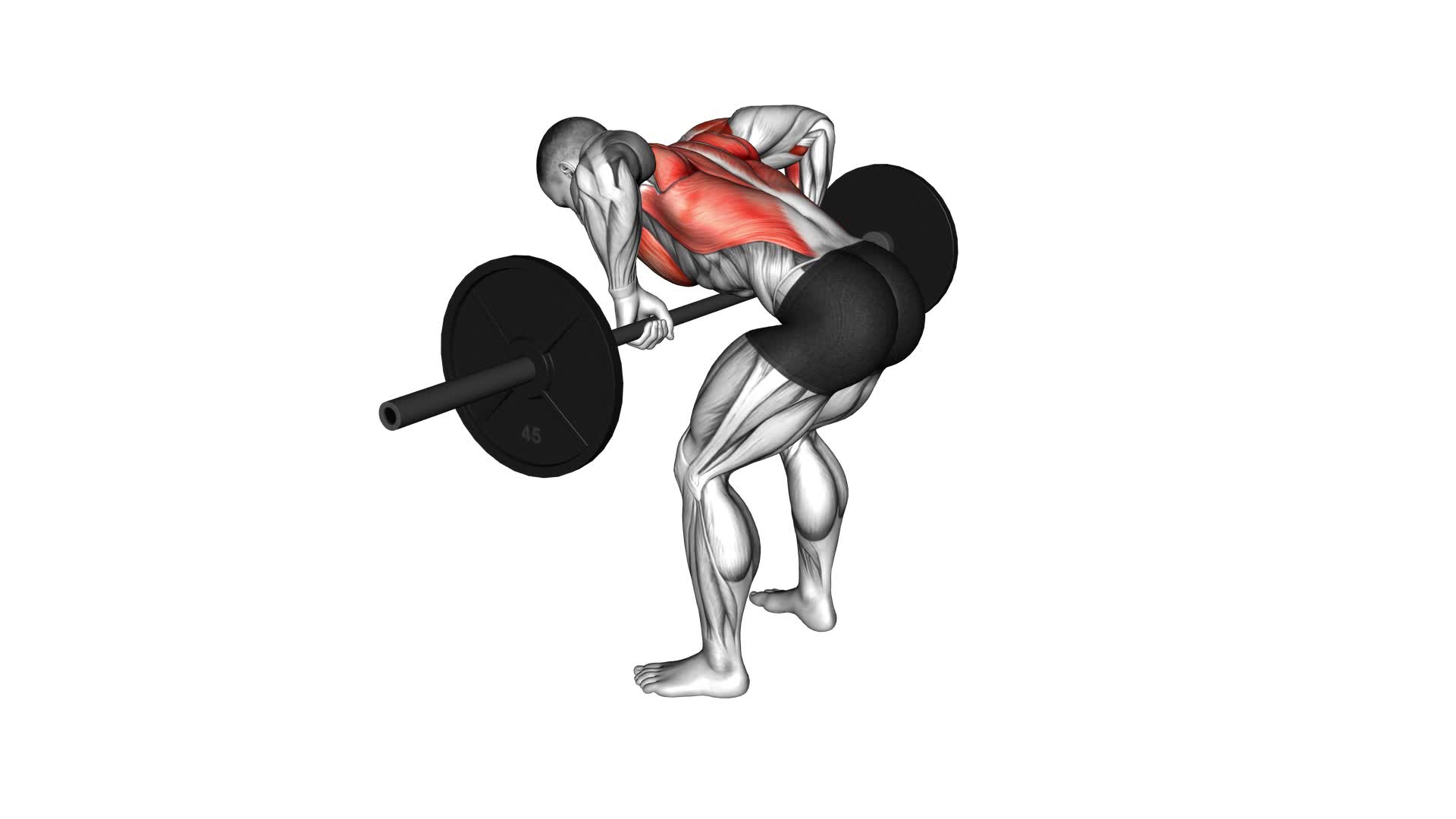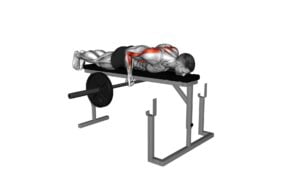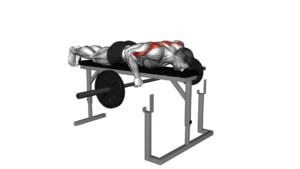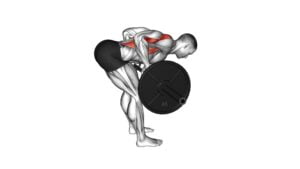Barbell Pendlay Row – Video Exercise Guide & Tips

Get ready to perfect your form and technique with the Barbell Pendlay Row! In this video exercise guide, we'll show you how to perform this powerful back exercise properly.
Watch This Exercise Video
You'll also get expert tips to maximize your results and avoid common mistakes. Whether you're a beginner or more advanced, we've got variations and progressions to suit your fitness level.
So grab a barbell and get ready to row your way to a stronger back!
Key Takeaways
- Barbell Pendlay Row is an efficient full-body exercise that targets multiple muscle groups.
- It improves posture, upper body strength, and enhances grip strength.
- It helps develop power and explosiveness, and improves performance in other exercises like deadlifts and pull-ups.
- There are variations and progressions of Barbell Pendlay Row that can challenge muscles and provide a more intense workout.
Proper Barbell Pendlay Row Form
To perform the Barbell Pendlay Row with proper form, focus on maintaining a strong and stable core. This exercise offers numerous benefits for your fitness routine. Firstly, it targets multiple muscle groups simultaneously, making it an efficient full-body exercise. The primary muscles worked during the Barbell Pendlay Row are the back muscles, specifically the rhomboids, lats, and traps. By engaging these muscles, you can improve your posture and upper body strength. Additionally, the rowing motion engages your biceps, forearms, and shoulders, further enhancing your upper body strength and stability.
Incorporating the Barbell Pendlay Row into your workout routine can also help improve your overall performance in other exercises, such as deadlifts and pull-ups. By strengthening your back muscles, you can enhance your pulling power and reduce the risk of injury during these movements. Moreover, this exercise promotes better body mechanics and a stronger core, which can translate into improved athletic performance in various sports and activities.
Now that you understand the benefits and muscles worked during the Barbell Pendlay Row, let's move on to some technique tips to ensure you perform this exercise correctly and maximize its effectiveness.
Barbell Pendlay Row Technique Tips
To perform the Barbell Pendlay Row with proper technique, focus on maintaining a strong and stable core.
This exercise offers many benefits, including targeting multiple muscle groups, such as the back, shoulders, and arms.
To execute the Barbell Pendlay Row correctly, start by standing with your feet shoulder-width apart, knees slightly bent, and your back straight. Grip the barbell with an overhand grip, slightly wider than shoulder-width apart.
Begin the movement by hinging at the hips and lowering your torso until it's parallel to the ground. Keep your core engaged and your back flat throughout the exercise.
Initiate the rowing motion by pulling the barbell towards your chest, leading with your elbows. Squeeze your shoulder blades together at the top of the movement and then slowly lower the barbell back down to the starting position.
Remember to breathe out as you pull the weight up and breathe in as you lower it back down.
Common Mistakes to Avoid
Avoid these common mistakes when performing the Barbell Pendlay Row to ensure proper technique.
First, make sure to maintain a neutral spine throughout the exercise. Avoid rounding your back or arching it excessively, as this can lead to injury. Keep your core engaged and your shoulders pulled back and down.
Another common mistake is using too much momentum or swinging the weight. This not only reduces the effectiveness of the exercise, but it also puts unnecessary stress on your lower back. Instead, focus on using controlled and deliberate movements, pulling the barbell towards your chest with your back muscles.
Improper grip can also lead to mistakes. Make sure to grip the barbell with a pronated grip, where your palms are facing down. This helps engage your back muscles and ensures a better distribution of the load. Avoid using an underhand or mixed grip, as this can put excessive strain on your biceps and wrists.
Lastly, avoid lifting too much weight that compromises your form. It's better to start with a lighter weight and gradually increase as you become more comfortable with the exercise. Remember, proper form is key to getting the most out of the Barbell Pendlay Row and preventing injuries.
Variations and Progressions
Try incorporating different variations and progressions of the Barbell Pendlay Row to challenge your muscles and continue making progress. Here are some options to consider:
- Different grip options for barbell pendlay row
- Overhand grip: This is the traditional grip where your palms face downward.
- Underhand grip: This grip variation targets your biceps more.
- Mixed grip: One hand uses an overhand grip while the other uses an underhand grip, providing a more secure grip.
- Incorporating explosive power into barbell pendlay row
- Plyometric rows: Perform a regular Pendlay row, but explode upward and release the barbell at the top of the movement, catching it again before starting the next repetition.
- Speed rows: Increase the speed of your rowing motion while maintaining proper form. This challenges your muscles to generate power more quickly.
- Resistance band rows: Attach resistance bands to the barbell and perform rows. The bands add resistance at the top of the movement, forcing you to explode through the sticking point.
By trying these variations and progressions, you can keep your workouts fresh and continuously challenge your muscles. This will help you break through plateaus and achieve new levels of strength and muscle growth.
Now, let's move on to the next section where we'll provide you with a sample barbell Pendlay row workout plan.
Sample Barbell Pendlay Row Workout Plan
Now let's create a sample barbell Pendlay row workout plan to help you achieve your fitness goals.
The barbell Pendlay row is a fantastic exercise that provides numerous benefits. It primarily targets the muscles in your back, including your lats, rhomboids, and traps. Additionally, it also engages your biceps, forearms, and core muscles.
To maximize the benefits of the barbell Pendlay row, it's recommended to incorporate it into your back training routine twice a week. Here is a sample workout plan:
Day 1:
- Warm up with some dynamic stretches and light rowing exercises.
- Perform 3 sets of 8-10 reps of barbell Pendlay rows.
- Rest for 1-2 minutes between sets.
- Follow up with other back exercises such as lat pulldowns and seated cable rows.
- Finish off with some core exercises like planks or Russian twists.
Day 2:
- Repeat the warm-up routine.
- Increase the intensity by performing 4 sets of 6-8 reps of barbell Pendlay rows.
- Rest for 1-2 minutes between sets.
- Incorporate other back exercises like bent-over rows and pull-ups.
- Conclude the workout with some lower back exercises like hyperextensions or reverse hypers.
Remember to start with lighter weights and gradually increase the load as you become more comfortable with the exercise. Always prioritize proper form and technique to prevent injuries and ensure optimal results.
Frequently Asked Questions
How Much Weight Should I Start With When Performing the Barbell Pendlay Row?
When starting the barbell Pendlay row, it's important to choose an appropriate weight. Consider your strength level and experience with similar exercises. Starting with a weight that challenges you, yet allows for proper form, is key.
Using a barbell for this exercise offers stability and allows for heavier loads compared to dumbbells. However, if you're new to weightlifting or have any limitations, starting with lighter dumbbells can be a good option to build strength and technique before progressing to the barbell.
Can I Use Dumbbells Instead of a Barbell for the Pendlay Row Exercise?
Yes, you can use dumbbells instead of a barbell for the Pendlay row exercise.
Dumbbell variations of the exercise offer several benefits, such as increased stability and unilateral training. By using dumbbells, you can also target each side of your body independently, helping to correct any muscle imbalances.
Additionally, dumbbells allow for a greater range of motion, which can further engage your muscles and enhance your overall strength and muscle development.
How Many Sets and Reps Should I Do for the Barbell Pendlay Row?
To perform the barbell Pendlay row correctly, you need to focus on your form.
Start by positioning your feet shoulder-width apart and hinge forward at the hips.
Keep your back straight and grab the barbell with an overhand grip.
Pull the barbell up towards your chest by squeezing your shoulder blades together.
Avoid common mistakes like using momentum or rounding your back.
As for sets and reps, aim for 3-4 sets of 8-12 reps to build strength and muscle.
Is It Necessary to Use a Lifting Belt for the Pendlay Row?
Using a lifting belt for the Pendlay row can provide several benefits during compound exercises. It helps to stabilize your core and lower back, reducing the risk of injury and allowing you to lift heavier weights.
However, it's not necessary for everyone. If you have a strong core and good form, you may not need one.
When performing the Pendlay row, common mistakes to avoid include using momentum, rounding your back, and not properly engaging your lats.
Can I Incorporate the Barbell Pendlay Row Into My Full Body Workout Routine?
Yes, you can definitely incorporate the barbell Pendlay row into your full body workout routine.
This exercise is great for targeting your back muscles and can help improve your overall strength and stability.
By adding the Pendlay row to your routine, you'll be able to work your back muscles in a different way than other exercises, promoting muscle growth and enhancing your posture.
It's a challenging and effective exercise that can bring great benefits to your full body workout routine.
Conclusion
In conclusion, the barbell Pendlay row is a highly effective exercise for developing a strong and well-rounded back. By maintaining proper form and following the technique tips, you can maximize the benefits of this exercise and avoid common mistakes.
Additionally, incorporating variations and progressions into your workout plan can help you continue to challenge your muscles and achieve even greater results.
Try adding the barbell Pendlay row to your routine and experience the benefits for yourself.

Author
Years ago, the spark of my life’s passion ignited in my mind the moment I stepped into the local gym for the first time. The inaugural bead of perspiration, the initial endeavor, the very first surge of endorphins, and a sense of pride that washed over me post-workout marked the beginning of my deep-seated interest in strength sports, fitness, and sports nutrition. This very curiosity blossomed rapidly into a profound fascination, propelling me to earn a Master’s degree in Physical Education from the Academy of Physical Education in Krakow, followed by a Sports Manager diploma from the Jagiellonian University. My journey of growth led me to gain more specialized qualifications, such as being a certified personal trainer with a focus on sports dietetics, a lifeguard, and an instructor for wellness and corrective gymnastics. Theoretical knowledge paired seamlessly with practical experience, reinforcing my belief that the transformation of individuals under my guidance was also a reflection of my personal growth. This belief holds true even today. Each day, I strive to push the boundaries and explore new realms. These realms gently elevate me to greater heights. The unique combination of passion for my field and the continuous quest for growth fuels my drive to break new ground.







